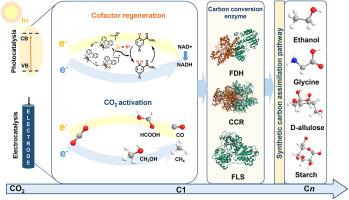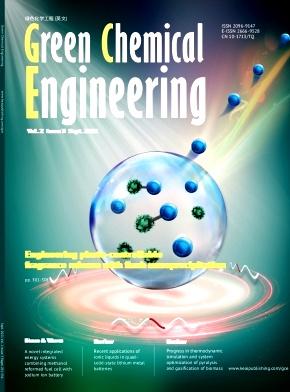Sustainable hybrid photo/electro-enzyme systems for CO2 conversion
IF 7.6
Q1 ENGINEERING, CHEMICAL
引用次数: 0
Abstract
Carbon dioxide (CO2), as an abundant and renewable carbon feedstock, holds immense potential for sustainable biomanufacturing. However, natural carbon fixation pathways, such as the Calvin-Benson-Bassham (CBB) cycle and the reverse tricarboxylic acid (rTCA) cycle, suffer from intrinsic limitations, including low catalytic efficiency, high adenosine triphosphate (ATP) consumption, and oxygen sensitivity. Recent advances in synthetic biology and metabolic engineering have pioneered artificial pathways (e.g., the crotonyl-CoA/ethylmalonyl-CoA/hydroxybutyryl-CoA (CETCH) cycle) that bypass central metabolism, achieving higher fixation rates with reduced ATP consumption. Concurrently, photocatalytic and electrocatalytic systems have emerged as complementary strategies to address cofactor dependency and CO2 activation thermodynamic barriers. This review summarizes breakthroughs in (i) rational design for CO2 conversion pathway optimization, (ii) photocatalysis, and (iii) electrocatalysis for CO2 activation and cofactor regeneration. By integrating these disciplines, synergistic systems achieve unprecedented efficiency in converting CO2 to Cn compounds (e.g., ethanol, glyoxylate, sugar, and starch) and establish a foundation for scalable carbon-negative biotechnologies. However, challenges remain, including enzyme denaturation under operational stresses, inefficiencies in multi-enzyme cascades due to kinetic mismatches, and the need for sustainable metrics to ensure net-negative carbon footprints. Future research should prioritize material innovation, CO2 assimilation system integration, and optimization to unlock higher efficiency CO2 conversion, aligning with global decarbonization goals while producing high-value chemicals.

可持续的光/电-酶混合系统用于二氧化碳转化
二氧化碳作为一种丰富的可再生碳原料,在可持续生物制造中具有巨大的潜力。然而,自然的碳固定途径,如Calvin-Benson-Bassham (CBB)循环和反三羧酸(rTCA)循环,存在固有的局限性,包括催化效率低、三磷酸腺苷(ATP)消耗高、氧敏感性高。合成生物学和代谢工程的最新进展开创了绕过中枢代谢的人工途径(例如,巴丁酰辅酶a /乙基丙二酰辅酶a /羟丁基辅酶a (CETCH)循环),在减少ATP消耗的同时实现更高的固定率。同时,光催化和电催化系统已经成为解决辅因子依赖和二氧化碳激活热力学障碍的互补策略。本文综述了在CO2转化途径优化的合理设计、CO2活化与辅因子再生的光催化、CO2活化与辅因子再生的电催化等方面的突破。通过整合这些学科,协同系统在将二氧化碳转化为Cn化合物(如乙醇、乙醛酸盐、糖和淀粉)方面实现了前所未有的效率,并为可扩展的负碳生物技术奠定了基础。然而,挑战仍然存在,包括操作压力下的酶变性,由于动力学不匹配导致的多酶级联效率低下,以及需要可持续的指标来确保净负碳足迹。未来的研究应优先考虑材料创新、二氧化碳同化系统集成和优化,以解锁更高效率的二氧化碳转化,与全球脱碳目标保持一致,同时生产高价值化学品。
本文章由计算机程序翻译,如有差异,请以英文原文为准。
求助全文
约1分钟内获得全文
求助全文
来源期刊

Green Chemical Engineering
Process Chemistry and Technology, Catalysis, Filtration and Separation
CiteScore
11.60
自引率
0.00%
发文量
58
审稿时长
51 days
 求助内容:
求助内容: 应助结果提醒方式:
应助结果提醒方式:


